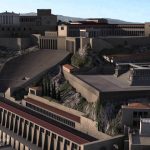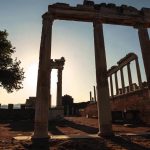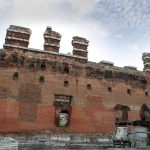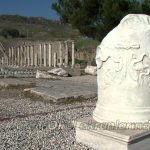HISTORY OF PERGAMUM
Pergamum, rising dramatically on a hilltop four hundred meters high above the valley of the River Kaikos, is among the most exciting places in Aegean Turkey to visit. Since it lies inland from the sea it did not attract Greek colonists during the Dark Age; a small indigenous population occupied the site. The legend of the mythical founder Telephos, the son of Heracles that is depicted in sculpture on the Altar of Zeus probably arose from a desire to enhance the city’s stature in the Hellenic mind. During the archaic period it remained a small hilltop city with a commanding and easily fortified position. In about 470 BCE King Gongylos of Eritrea, who supported the Persians, ruled there. In 399 BCE the Spartans, attempting to gain territory in Anatolia after the Peloponnesian War, seized it for a short while with the help of the historian and mercenary Xenophon; but they failed to hold it.
.
After his victory at the Battle of Granicus in 334 BCE, Alexander the Great bypassed Pergamum on his march south to Sardis and Ephesus. But his successors, the Diadochi who fought each other for the control of his empire impacted the city’s future: Lysimachus held Pergamum, but after his rival Antigonus died at the battle of Ipsus (301 BCE), he gave the command of the city to Philetairos, a Greek from the Black Sea region, who had earlier supported Antigonus, but changed sides in the conflict. Lysimachus also entrusted him with the safekeeping of his war booty worth 9,000 silver talents that he had deposited in the citadel there. Philetairos served Lysimachus until 282 BCE, when he betrayed him by suddenly turning over both the citadel and the treasury to his enemy Seleucus. But within a few months Lysimachus and Seleucus had both been slain, opening the way for Philetairos to rule Pergamon. Despite his repeated treacheries, Philetairos governed wisely until his death in 263. Making use of the rich treasury, he initiated a major campaign of building on the Acropolis, strengthening its walls and raising temples to Demeter and to Athena, the patron goddess of the city. He gave generous support to art and culture, for which Pergamum on was celebrated for centuries. Thus, his city rivaling Alexandria and Athens, was revered for architecture, sculpture, philosophy and, above all, its library. It also led the Greek world in the field of medicine.
.
Pergamon remained, nominally, under Seleucid control but Philetairos enjoyed autonomy. Although impotent and unmarried, he founded the Attalid dynasty of kings that ruled until 133 BCE. He adopted his nephew Eumenes and passed the reins of power to him after his death. The generations of Attalids that followed cultivated friendship and military solidarity with the Athenians and the Romans, but remained steadfast against the ambitious Macedonians and Seleucids. By limiting warfare mainly to fighting those who directly threatened them, they gained wealth and territory. Eumenes I (r. 263-241 BCE) strengthened the Attalid hold on Pergamum when he joined with Ptolemy II to defeat the Seleucid king Antiochus I in 261. After this victory, he presided over a period of peace, disturbed only by attacks from marauding Galatians, a Celtic people from Central Anatolia known to the Romans as Gauls. Eumenes probably kept them at bay by paying the tribute they demanded. He was succeeded by his cousin Attalos whom he had adopted.
.
Attalos I (r. 241- 197 BCE) defeated the Galatians decisively and was acclaimed with the name of “Sorer” (saviour) He sided with the Romans against Philip V of Macedon. While warding off invaders and gaining favor with the Romans, Attalos I established a long period of stability. His admiration for Athenian culture led him to send his son Eumenes to be educated in Athens. Attalos I acted as a benefactor to other cities, including nearby Assos, by sending skilled craftsmen to assist them with their architectural ventures. He also dedicated a stoa at Delphi. The reign of his son Eumenes II (r. 197-159 BCE) was a golden age for Pergamon. As a student in Athens he fell under the spell of the Acropolis and felt inspired by it to add to the architectural glory of his own city. Near the foot of the hill he erected a propylon, a formal gateway to the Acropolis, the beginning of a unique urban promenade from which the architecture of the city would gradually be revealed. His greatest achievements included the enlargement of the theatre, the steepest in the Greek world, which seated 10,000 spectators; building the library which was second only to the library at Alexandria, and constructing the Altar of Zeus, one of the greatest monuments of the Hellenistic world. He also levelled terraces on the lower slopes to allow for new buildings and urban spaces. He added a Lower Agora and a vast gymnasium. The local andesite stone gave most of the architecture a grey color that fused it to the hill, but white marble allowed Pergamene sculptors to create some of the finest sculpture of the Hellenistic era. In appreciation of his education in Athens, he gave support to the city’s philosophical schools and built the impressive Stoa of Attalos in the Athenian Agora. During his reign, agriculture and manufacturing thrived, most significantly the making of “charta pergarnena” parchment prepared as an alternative to papyrus for the production of books. He also founded the sacred city of Hierapolis in Phrygia and, in order to expand trading opportunities, he established Attaleia, now known as Antalya, on the Mediterranean coast.
.
Eumenes followed his father as a military leader, resisting attacks by the Galatians and the kings of Pontus, holding back Macedonian expansion, and opposing the Seleucids. He allied himself with the Romans against the Seleucid king Antiochus III, who, as a champion of Greek freedom tried to drive the Romans from mainland Greece. The Romans defeated him at Thermopylae in 192 BCE and followed him to western Anatolia, where Eumenes joined them with his own army. In 190 BCE, Eumenes helped the Roman commanders Cornelius Scipio Asiaticus and his brother Scipio Africanus to defeat Antiochus in the fateful Battle of Magnesia.
.
At this time, the Romans had no ambition to administer new provinces in Anatolia; they believed that the strong Pergamene Kingdom could provide a bulwark against the Seleucid threat. Therefore, after the treaty of Apamea in 188 BCE which mandated harsh terms against the Seleucids, the Romans gave Eumenes control of all the Seleucid territories in Western Anatolia. Thus, the Attalid kings of Pergamon, after little more than a century of rule, became the masters of the independent Greek cities on the Aegean coast without attacking any of them. Pergamon, now the capital of an empire, which had never been invaded, represented Hellenistic architecture and sculpture at its peak.
.
After the death of Eumenes, whose son Attalos had not reached his majority, the throne passed to his brother Attalos II “Philadelphus” (r. 160-138 BCE) who ruled jointly with Eumenes at the end of his reign and distinguished himself as a military commander. He made several diplomatic missions to Rome and supported the arts and sciences. His nephew Attalos III (13 8-133 BCE) who succeeded him, was less popular with his subjects, but ruled during a period of peace. He devoted time to studying medicine, botany and horticulture, gaining respect from Galen, the most celebrated doctor of his era. With disregard for other human beings, he used prisoners as subjects in his experiment on poisonous plants. Having no male heirs and, perhaps seeing the inevitability of Roman rule in Anatolia, he bequeathed Pergamon and all her possessions to the Roman republic. The transition, which might have ensured peace and continued prosperity, turned out to be painful. A force of peasants, mercenaries, slaves and other opponents, assembled by an illegitimate son of Eumenes II, prevented the Romans from grasping their prize; three years passed before they controlled the city. Fifty years later the citizens of Pergamon showed their aversion for Roman rule again when they joined with Mithridates VI of Pontus who occupied the city and attempted to eject the Romans. A brutal massacre of Romans ensued. Soon after the quelling of this revolt, the cities of the Pergamene Empire became the Roman province of Asia. Pergamon was chosen as the capital of the province until that role was transferred to Ephesus.
.
During the Roman period Hellenistic buildings dominated the city, but the emperor Augustus restored and embellished several of them and Caracalla rebuilt the Temple of Dionysus in marble. Hadrian, who inherited the imperial throne as Trajan’s adopted son, made the most substantial addition to the Acropolis with the monumental Temple of Trajan. Both Trajan and Hadrian were worshipped there. The Corinthian columns of this temple, the tallest elements on the citadel today, give an idea of the grandeur of Roman Pergamon.
.
In the Christian era Pergamon became the seat of a bishop and, around 90 CE was named by John the Divine in the Book of Revelation as one of the ‘seven churches of the Apocalypse.’ The words in John’s letter to the Church of Pergamon know where thou dwellest, where the throne of Satan is’ have been associated with the Altar of Zeus, but more likely referred to the Temple of Trajan, where the emperor demanded to be venerated as a god. A Christian named Antipas was burnt at the stake for refusing to worship at the imperial temple. After Constantine had given legitimacy to their faith in 313 CE, the Christians of Pergamon built a church inside the roofless Roman temple to the Egyptian gods. Under Byzantine rule, Pergamon which had suffered earthquake damage began to decline; as Muslim raids became a threat new defensive walls were built, using spolia from collapsed buildings including carved panels from the Altar of Zeus.
Pergamum
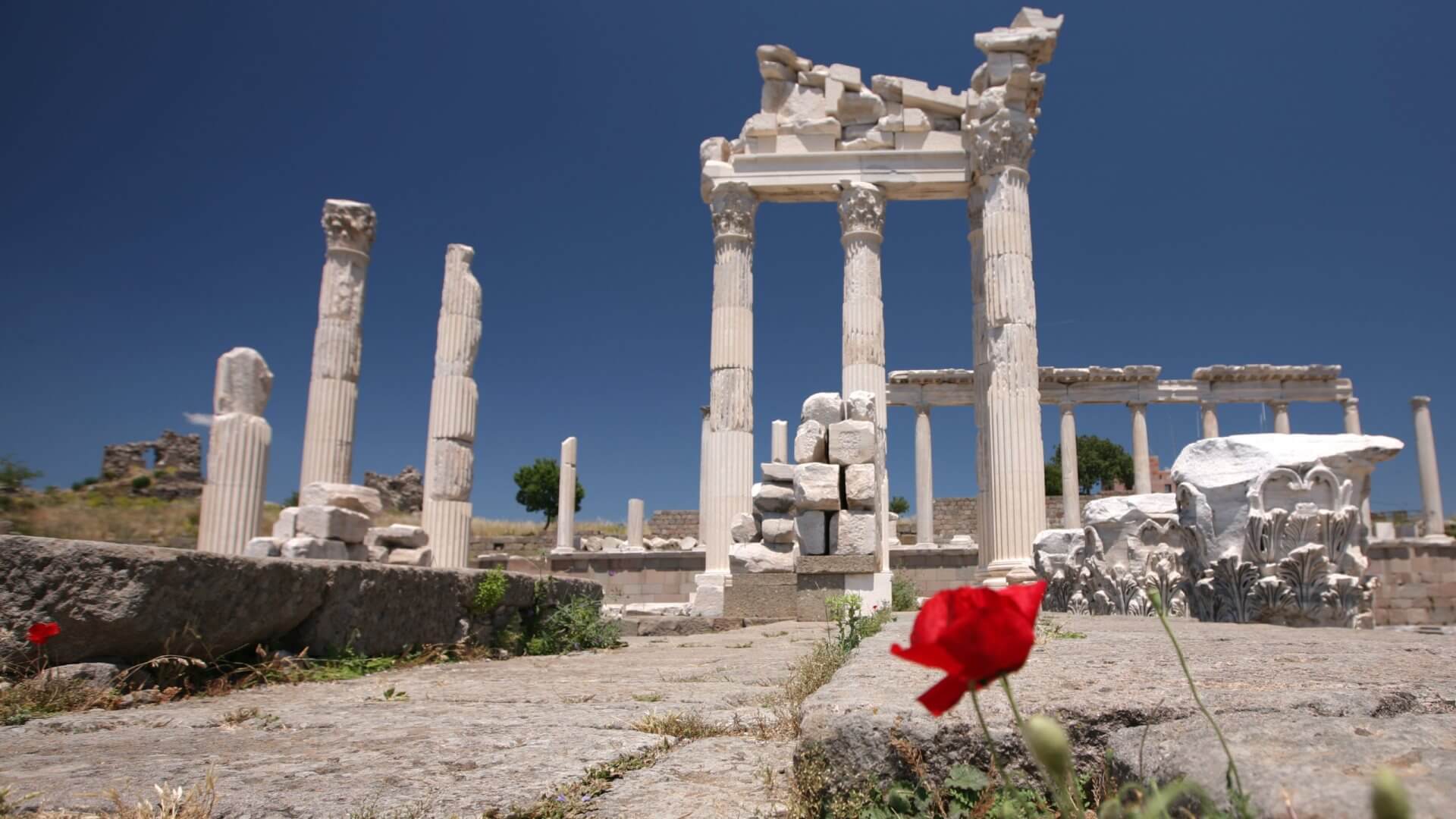
Categories :
Turkey Tours and Travel
